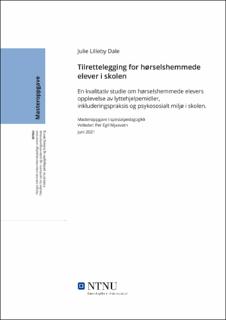| dc.contributor.advisor | Mjaavatn, Per Egil | |
| dc.contributor.author | Dale, Julie Lilleby | |
| dc.date.accessioned | 2021-10-07T17:23:45Z | |
| dc.date.available | 2021-10-07T17:23:45Z | |
| dc.date.issued | 2021 | |
| dc.identifier | no.ntnu:inspera:79273327:30697285 | |
| dc.identifier.uri | https://hdl.handle.net/11250/2788532 | |
| dc.description.abstract | Denne studien har til hensikt å finne ut hvordan elever med hørselstap opplever tilretteleggingen deres i skolen. Søkelyset rettes mot hvordan tilretteleggingen for elevene påvirker hørselshemmede elevers opplevelse av det psykososiale miljøet på skolen, og hvordan man kan skape gode inkluderingspraksiser for elevene.
Problemstillingen som danner grunnlaget for oppgaven er som følger: Hvordan opplever elever med hørselstap tilretteleggingen på skolen deres? For å belyse problemstillingen er det formulert et forskningsspørsmål: I hvilken grad opplever eleven at tilretteleggingen på skolen bidrar til at eleven opplever et godt psykososialt miljø på skolen?
I oppgaven presenteres relevant teori og forskning rundt hørselstap. Teorigrunnlaget for denne oppgaven omhandler blant annet kommunikasjon, strategier i forbindelse med hørselstap og hørselstekniske hjelpemidler. Det er gjennomført kvalitative forskningsintervjuer med fire elever som har en form for hørselstap. Studien er bygget på hermeneutisk vitenskapsteori.
Resultatene i studien indikerer at elever med hørselstap opplever utfordringer med kommunikasjon på skolen. Dette skyldes hovedsakelig for høyt støynivå samt læreres og medelevers holdninger til hørselstap. Informantene signaliserer at de ønsker at støynivået skal senkes og at lyttehjelpemidlene skal brukes mer i undervisningen. Informantene gir eksempler på praktiske tiltak og virkemidler for å oppnå en bedre inkluderingspraksis. Informantenes utsagn tyder på at skolen ikke legger nok innsats i å skape et godt psykososialt miljø for disse elevene. Holdningene til lærere og elever går direkte utover elevenes inkludering i skolen. Det viser seg at ikke alle lærere og elever bruker lyttehjelpemidlene, og at medelever misbruker hjelpemidlene. Resultatet i studien gir grunn til å stille spørsmål om hvor grensen går mellom inkludering og ekskludering av elever med hørselstap i skolen. Videre forskning rundt inkluderingspraksis for hørselshemmede elever bør iverksettes for å belyse ovennevnte spørsmål. | |
| dc.description.abstract | The purpose of this study is to find out how pupils with hearing impairments experience the quality of the facilitation done by their schools. The spotlight is directed towards how the facilitation influence their view of the psychosocial environment at the school, and how to create satisfactory practices for inclusion of these pupils.
The issue that is the foundation of this study is as follows: How do pupils with hearing impairments experience the facilitation done by their schools? A research question is formulated to enlighten the issue: To what degree do the pupil experience that the facilitation done by the school contributes to a perception of a good psychosocial environment by the pupil?
Relevant theory, research about hearing impairment, is presented. The theory foundation of this study includes, among other things, hearing loss, strategies related to reduced hearing and hearing aids. Qualitative research interviews with 4 pupils with hearing impairments have been performed. The study is built on hermeneutic science theory.
The results of this study indicate that pupils with hearing impairments experience challenges regarding communication at school. This is mainly due to high level of noise, together with the attitude of the teacher and other pupils regarding hearing impairments. The informants indicate that they wish that the level of noise would be reduced, and that the hearing aid tools should be more used in the teaching. Examples are given regarding practical measures and methods to achieve improved practices of inclusion. The statements for the informants indicate that the schools are not putting enough effort into creating a good psychosocial environment for these pupils. The attitude of the teachers and the other pupils works against inclusion with other pupils at school. It turns out that not all teachers use the hearing aid tools, and the other pupils misuse them. Given the result in this study, a question is raised: Where is the borderline between inclusion and exclusion of the pupils with hearing capabilities? Further research regarding practices of inclusion for pupils with reduced hearing capabilities is recommended with this question in mind. | |
| dc.language | nob | |
| dc.publisher | NTNU | |
| dc.title | Tilrettelegging for hørselshemmede elever i skolen | |
| dc.type | Master thesis | |
